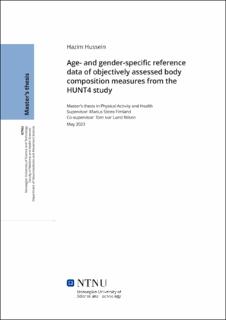| dc.description.abstract | Background The human body composition parameters have been associated with morbidity and all-cause mortality. Therefore, several measures to assess body composition have been investigated and reference values for them were established such as body mass index and waist to height ratio. However, direct reference values for different body composition parameters would provide a better health indicator but currently there are no established reference values for these parameters.
Aims To provide age- and gender- specific body composition reference values for the Norwegian population.
Methods Data collected from the fourth wave of the Trøndelag Health Study (HUNT4), a population-based cohort study, using the InBody 770 Body Composition Analyzer with 51,477 participants, aged 19-102, during the period 2017-2019. The current study is a descriptive study that assessed the variables: Height, Weight, Waist Circumference, Waist to Height Ratio (WHtR), Body Mass Index (BMI), Percent Body Fat (PBF), Body Fat Mass (BFM), Skeletal Muscle Mass (SMM), Skeletal Muscle to Height Ratio (SMtHR), Fat Free Mass (Fat Free Mass), Soft Lean Mass (SLM), and Visceral Fat Area (VFA). In addition, the parameters: BMI, PBF, SMM, and SMtHR were used to create reference curves.
Results The lean mass parameters (SMM, SMtHR, SLM, and FFM) were higher in males, with a trend of stabilization or slight increase with age until the mid-40s range and a subsequent continuous decline afterwards. Fat parameters (PBF, BFM, and VFA) were higher in females, with an almost linear trend of increasing with age. Furthermore, general anthropometric parameters (Weight, BMI, Waist Circumference, and Waist to height Ratio) increased with age until the mid-50s range and then started dropping with age, and they were higher in males.
Conclusion The current study provides age- and gender- specific body composition reference values for the adult Norwegian population and additionally provides reference curves for the parameters: BMI, PBF, SMM, and SMtHR. | |
